Archives
The Cannonball Run and the 1972 Cotton Owens Dodge Challenger
"Coast-to-Coast in 38.05 Hours"
Dedicated to our friend and fellow scofflaw, Brock Yates.
October 21, 1933 – October 5, 2016
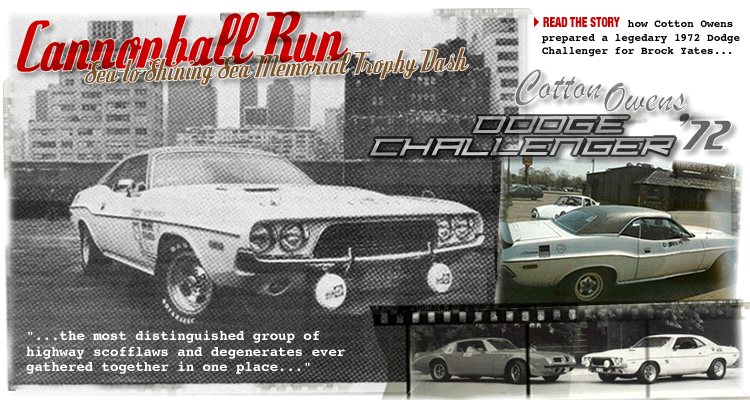
"Within hours after the stories of the second Cannonball appeared in
Car and Driver and
Autoweek, my phone began to ring around the clock. Seeminly every sports car nut, hot rodder, closet anarchist, and general Hell-raiser in the nation was ready to run if another race was organized. We had to go again. My first challenge was to find another automobile. Kirk White had sold the Ferrari and it was unlikely that he would be able to replace it with one as potent and reliable. I spoke with Moon Mullins, my old Dodge pal who had provided the original Moon Trash II van, and he suggested a heavily modified Challenger. I had learned that long range, at least 400 miles, and an easy 90-100 mph cruising speed were the keys to winning the Cannonball, provided the highway patrols could be avoided and a quick, efficient route was chosen. At the time, Dodge was heavily involved with Spartanburg's Cotton Owens, a great ex-stock car driver who was preparing David Pearson's machines for the NASCAR Grand National (Cup) wars.
Mullins had a 340-cubic-inch Challenger in the press fleet that could be converted by Owens into a proper Cannonball car, and we made a deal to have the car transformed into a latter-day liquor hauler set up for cross-country running. I flew to Spartanburg to pick up the Challenger from Owens. I had known Cotton well since doing a story with him and David Pearson several years earlier. He was a leathery little man, with a quick smile and a deeply competitive streak that had carried him to a number of major NASCAR victories prior to his retirement during the gritty, fender-bashing years of the 1950s. Cotton was confident the Challenger would run the distance without breathing hard, based on his years building stock cars and the local knowledge that he had gleaned from illegal earlier, high-speed experiences."
- Brock Yates, excerpted from
Cannonball! World's Greatest Outlaw Road Race
 The Cannonball Run and the 1972 Dodge Challenger : Coast to Coast in 38.05 hours
Steve Behr and Brock Yates, New York; 1972 Dodge Challenger; 38 hours, 3 minutes; average speed, 76.3 mph:
The Cannonball Run and the 1972 Dodge Challenger : Coast to Coast in 38.05 hours
Steve Behr and Brock Yates, New York; 1972 Dodge Challenger; 38 hours, 3 minutes; average speed, 76.3 mph:
"
A dazzling dumb performance by not one but two former winners in a really good car. The Cotton Owens Challenger, which finished second in the 1972 event, was even better this year. Work by super builder-designer Ron Nash—suspension and brake modifications, a Holley 800-cfm carb, Crager headers, Goodrich T/A radials, transmission oil cooler and other trick parts plus prototype Cibie driving lights and an experimental Autotronics Super Snooper radar unit with a maximum range of five miles—made the car a quiet, sure-fire, 130-mph winner.
That was effectively nullified by a hectic departure (a fantastic collection of food was left at curbside, meaning a Coast-to Coast diet of M&Ms and Cokes) and a half-hour hideout behind a gas station after a trucker was heard broadcasting a description of the car to the Smokeys. Running behind schedule, route improvisations were made that lost even more time."
Brock Yates invented the
Cannonball Run, which, before it became a silly movie, was an actual and very illegal high-speed road race across America's highways.
Yates was a writer for
Car and Driver, when, in early 1971, he announced a coast-to-coast race from New York City to Redondo Beach, California. The race had one rule:
"All competitors will drive any vehicle of their choosing, over any route, at any speed they judge practical, between the starting point and destination. The competitor finishing with the lowest elapsed time is the winner."

If you think it sounds nutty, you're not the only one -- Yates himself, with two associates and his 15-year-old son, were the only team that showed up at the first race, but race they did. Yates wrote about his high-speed adventures in
Car & Driver, and the next
Cannonball Sea-to-Shining-Sea Memorial Trophy Dash, seven months later, had eight entrants.
Additional
Cannonball Runs were run in 1972, 1975, and 1979, the last with more than 40 racing teams. And winners received only a trophy, a "free-form sculpture" made of wrenches, hammers and pliers.

By the fifth race, though there had been no serious accidents, even Yates knew it was just a matter of time until something deadly brought his anarchist event to an end, so the
Cannonball Run was quietly discontinued. The events' fastest time, for the trip from New York to California, was 32 hours and 51 minutes. Which, if you think about it, is a long way to go and a short time to get there.
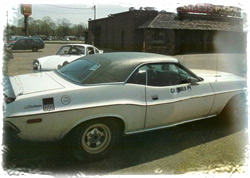 Smokey and the Bandit
Smokey and the Bandit was obviously Yates-inspired, and Yates co-wrote
Smokey and the Bandit II. He also wrote the original
Cannonball Run, and played himself, with dialogue like "You are certainly the most distinguished group of highway scofflaws and degenerates ever gathered together in one place."

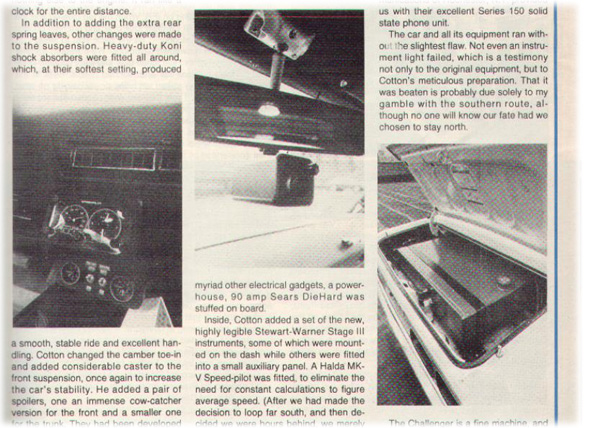
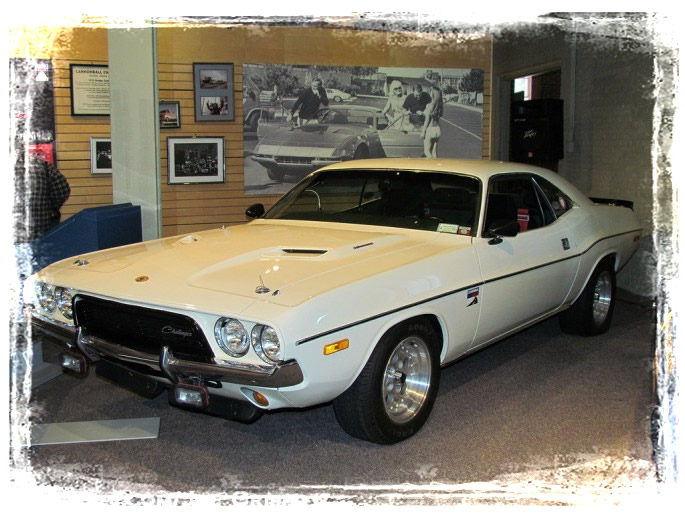
The Cotton Owens Cannonball Run Challenger today, restored to its former glory.
THE CANNONBALL EXPRESS
By Brock Yates
From the August, 1975 issue of
Car and Driver
Look out, America, here they come!
The timing was perfect. Here come the 18 finishers of the fourth Cannonball Baker Sea-to-Shining-Sea Memorial Trophy Dash, straggling into the Portofino Inn in Redondo Beach, looking like a pack of chain-gang fugitives…just as the Los Angeles papers are carrying full-page ads for the premiere of a new Hollywood biggie called Death Race 2000.
Ideal. Flawless coordination, you might say. Since the first Cannonball was run, in May 1971, those tinsel-town kulture freaks have given up Two Lane Blacktop, Vanishing Point, Sugarland Express, The Getaway and a trash can full of other get-it-on, open-road races and chases. And now, as the frosting on this pile of bent and smoking wreckage, we present Death Race 2000, wherein the thrill-seeker auto-cultists of the future have become so jaded that they score a Coast-to-Coast race on the basis of the number of people they snuff along the route, which apparently includes everything from blasting through playgrounds to T-boning senior citizens on park benches to collecting Salvation Army bands on street corners. Who said, "life imitates art"?
Here we are, with the fourth Cannonball history despite that the farce known as the 55mph speed limit, with all the starters having completed the 2900-mile run at a totalaverage speed of 70.7 mph—while they traveled over 52,000 high-speed miles without so much as mussing anybody’s hair. During the for Cannonballs that have been run, the 149 participating drivers, riding in 61 vehicles ranging from quarter-century-old Studebakers to 175-mph Ferraris. Have logged over 160,000 miles of extremely fast driving and have caused no recorded inconveniences to the world at large.

So why am I sitting here waiting for the first idiot letter from some decent, concern, responsible, safety-minded law-abiding motorist to berate us for advancing the cause of highway murder and compare the Cannonball to Death Race 2000? Because I can see some stiff winding up with his pitch already, and there’s nothing to do but wait for it to come wobbling over the plate, but it does point up to one shadowy benefit of the Cannonball: Everyone who gets involved in this weirdo deal agrees that the Cannonball is a litmus paper for personalities: The good guys love it, the stiffs hate it. That’s a completely reversible view, depending on your personal outlook, but the Cannonball remains a solid measurement for discovering kindred souls.
The Cannonball had a lot of kindred souls, as it turned out. Over 60 made serious applications to compete, which meant they were willing to pay the $50 entry fee plus $200 to be donated to charity. (Because several entrants donated more than the minimum, we were able to forward $3850 to a variety of public-service organizations ranging from the American Cancer Society to the Jacksonville, Florida YMCA in the name of Cannonball competitors.) Based on arbitrary judgments involving driving credentials, type of car, personal stability and general karma, we finally selected 22 teams for the starting field, although four were unable to run because of business conflicts, car problems and sundry ailments. Eighteen automobiles running the gamut from pickups to Porsches, Bristols to Buicks, containing 50 men and 2 women ranging in age from 21 to 55, gathered on the roof of the Red Ball Garage in midtown Manhattan on a sunny day in late April to start the fourth Cannonball.
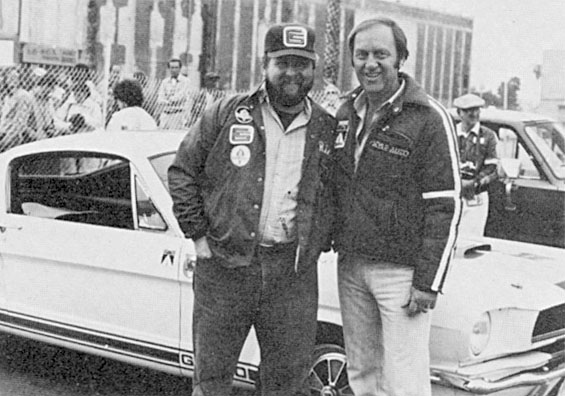
The last tow Cannonballs had been held in November of 1971 and 1972, when snow made the run through the Rockies look like a motorized Ice Follies. Because that part of the run comes at night, sometimes during the twenty-sixth/twenty-eighth hour—when fatigue is a factor—we thought a springtime start might be safer. We also figured it would be faster. That theory was in substantial conflict with almost everybody who had been reading about speeding-arrest programs by various highway patrols along the Cannonball route---especially Ohio’s and California’s---and the general limitations of the 55-mph national limit. But our optimism about a faster Cannonball was based on three advantages that the competitors would enjoy over their predecessors: 1/ they would probably be able to drive on roads bare of snow or ice; 2/ for the first time, the Autotronics Snooper radar detector would be a major factor in the event; and 3/ only Boy Scout troops and cab companies were using citizen-band radios during the 1972 Cannonball, but that was before the great trucker’s strike and the development of the incredible national network of highway entertainment, random roadway bullshit transfer and Smokey Bear detection that now operates in every corner of the nation. This system works so well that a Smokey on an Interstate can’t fire up his Ford without 40 guys with radios blabbing the news all over the country. Like the man in the big Kenworth said to us, "That’s for sure, guy; we see a Bear and we’ll definitely put him on the air." For these three reasons, plus an ever-increasing body of knowledge about the best routes, not only across the country but in and around New York and Los Angeles (which can eat up over three hours of the total trip time), we felt a lot of people were going to turn the Cannonball into a very fast event.
We were partially correct: The Old record was broken, but the rest of the field was far behind; the second and third place cars were two hours slower than the winners, meaning that the fifth car in 1971 and the third-place car in ’72 recorded better times than the number-two finisher this year. Yet the average speed of the 18-car field surpassed by over two mph the overall average of 68.2 mph recorded by the 27 finishers in 1972. If the speeds were off slightly, it was hardly the fault of Smokey and his friends. Less than a dozen arrests and warnings were issued for the entire field, although the winners set another record with Big Casino in the Cannonball speeding fines: a $250 donation to the Sate of Ohio. Everyone arrived at the Portofino convinced that law enforcement was much lighter than they had expected, and that the law officers encountered along the way were for the most part good guys. A substantial percentage of the Smokeys that I, for one, have met have been empathetic to high-performance cars and driving, and are embarrassed and distressed about having to enforce the 55-mph limit. They were operating within a lunatic system, and if given their choice, a lot of them would scrap their radars and Vascars and begin to operate as genuine helpers on the highway.
As far as safety was concerned, it was all that anyone could have hoped for. Eighteen cars started; 18 cars finished. Nobody even got a wheel in the dirt, despite the fact that speeds over 120 mph—a velocity that the National Safety Council suspects means certain death in the first few feet of travel—were used by at least six of the faster cars. The only casualties were three jackrabbits nailed by the winning Ferrari in Arizona, a possum that cleaned part of the spoiler off the third-place Challenger in Indiana and about 60 trillion bugs pulverized in Oklahoma, Texas and Kansas.
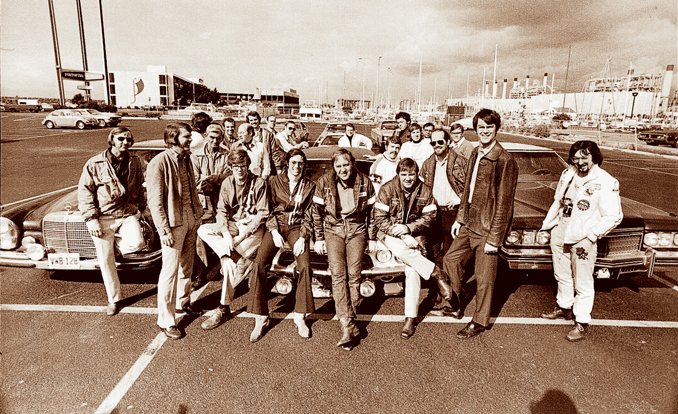
Based on finishing positions, here’s the way it went:
1/Jack May and Rick Cline, Gainesville, Florida; 1973 Ferrari Dino 246 GTS; 35 hours, 53 minutes (new record); average speed, 81.0 mph: This whole operation was lean and clean; Cline and May are small, slightly built guys who fit perfectly into their slippery, fast and efficient little Dino. They left New York about an hour after the rest of the starters and blasted west, using the Ferrari’s 140-mph top speed when they could. Both of them have extensive racing experience (Cline is a top engine-builder in Southeastern road-racing circles) and the trip was completed without bother except for the Arizona rabbits and the Ohio arrest. Says May, "That Ohio cop was a super guy. I actually think he was basically sympathetic. He sure was helpful in showing us the fast way back to the Interstate from the justice of the peace." Their record would have even better had they planned a better route through the Los Angeles morning rush-hour traffic. Slow running, capped by getting lost a few miles from the finish, cost them the chance to break the old record by a big margin.
2/Jack McCoy, Peggy McCoy and Gary Johnson, Modesto, California; 1973 Chevrolet pickup; 37 hours, 50 minutes; average speed, 76.7 mph: Runnin’ steady, that was the secret. Jack McCoy, one of the best stock-car drivers in West Coast history, did what you’re supposed to do in the Cannonball—ran 90 to 95 mph, chose a quick and efficient route, stayed our of trouble and made rapid refueling stops to blow off a lot of competitors who had 20- to 50-mph advantages in top speed. McCoy was the last to leave the Red Ball Garage, a few minutes after midnight, and eased through the deserted streets of New York and the open expanses of New Jersey and Pennsylvania, gobbling up time. Co-driving with fellow racer Gary Johnson (McCoy supplied the vehicle for the Cannonball, Johnson will return the favor for the Baja 1000) while his wife Peggy navigated and watched for cops, McCoy made a nearly perfect run.
3/Steve Behr and Brock Yates, New York; 1972 Dodge Challenger; 38 hours, 3 minutes; average speed, 76.3 mph: A dazzling dumb performance by not one but tow former winners in a really good car.
The Cotton Owens Challenger, which finished second in the 1972 event, was even better this year. Work by super builder-designer Ron Nash—suspension and brake modifications, a Holley 800-cfm carb, Crager headers, Goodrich T/A radials, transmission oil cooler and other trick parts plus prototype Cibie driving lights and an experimental Autotronics Super Snooper radar unit with a maximum range of fivemiles—made the car a quiet, sure-fire, 130-mph winner. That was effectively nullified by a hectic departure (a fantastic collection of food was left at curbside, meaning a Coast-to Coast diet of M&Ms and Cokes) and a half-hour hideout behind a gas station after a trucker was heard broadcasting a description of the car to the Smokeys. Running behind schedule, route improvisations were made that lost even more time.
4/Wes Dawn, Hollywood, California; Gil Nickel, Park Hill, Oklahoma; 1973 Mercedes-Benz 450SL; 38 hours, 16 minutes; average speed, 75.8 mph: This was Wes Dawn’s third Cannonball, and he is one of a hard-core cadre of six who have run in three or more C-balls. After bumming a ride in 1971 in an MGB that crapped out in Columbus, Ohio, Wes ran seventh in 1972 in a Vega (getting five tickets along the way). This year, he and Gil Nickel took the northern route across Interstate 80 to Salt Lake City, then south through Las Vegas. Dawn and Nickel may have established a record of sorts by running the heavily patrolled road between Vegas and Los Angeles in three hours flat, averaging just over 100 mph.
5/Leo Lynch, Sewickley, Pennsylvania; Dan Rowzie, Alexandria, Virginia; 1973 Porsche Targa; 38 hours, 39 minutes; average speed, 75.1 mph: This silver Targa, with its three-liter RSR engine, was easily the fastest car in the Cannonball. Leo claims to have run in excess of 160 mph with it on numerous occasions, although its speed was somewhat neutralized by three tickets and another trucker’s CB alert to the Smokeys that forced them into extended hiding in a HO JO’s restaurant in Pennsylvania. (Lesson learned on the Cannonball: Don’t hassle the truckers by passing them too briskly. They will fink to the cops—based on the logic that if the Smokeys are chasing somebody else, they can put the hammer down.)
6/Sandy Satullo and Sandy Satullo II, Fairview Park, Ohio; Jack Pearson, Westlake, Ohio; Jack Howlett, Rocky River, Ohio; 1975 Buick Electra; 38 hours, 45 minutes; average speed, 74.9 mph: One thing about the Cannonball: If you’re in it, you can win it. Satullo, one of the best offshore powerboat racers in the world, figured that his box-stock ’75 Electra, in all its metallic-silver, flattop-sized splendor, had as good a chance as any car. Save for a fuel cell, CB, radar detector and four very serious motorists, it was like any other Buick swishing along the Interstates. They made six stops, got 12.15 miles to the gallon and, like Dawn and Nickel, tried the northern route. They maintained a low profile, did nothing foolish and come home ahead of far faster machinery.
7/Jim Atwell, Alexandria, Virginia; Chick Stanton, McLean, Virginia; 1975 Porsche Carrera; 38 hours, 56 minutes; average speed, 74.5 mph: This pair had a practice run of under 37 hours under their belts and were considered top contenders until they made a common mistake: They overestimated the intensity of the 55-mph enforcement. They simply ran their immaculate Carrera too slowly during the opening hours, which destroyed their chances for a high average speed. Atwell, a retired Army colonel, and Stanton, a Porsche-Audi salesman, swear they won’t make the same mistake again.
8/Ray Walle, Princeton, New Jersey; Jeff Martini and Pierre Honegger, New York; Tom Kozlowski, San Diego, California; 1975 Mazda RX-4 station wagon; 39 hours, 22 minutes; average speed, 73.6 mph: This was what you call your E-Z Wider Racing Team. If you don’t know what E-Z Wider makes, don’t ask. Ray Walle (a Mazda dealer and road racer), Jeff Martini (a New York staffer for Rolling Stone), Tom Kozlowski (a freelance photographer) and last minute addition Pierre Honegger (a Time magazine stringer) wedged themselves into a Mazda wagon and, operating as tow teams—one slept while the other drove—motored steadily, picked up one ticket and arrived feeling amazingly fit.
9/John Buffum, Burlington, Vermont; Vicki Buffum, Shelburne, Vermont; 1972 Porsche Carrera Rally; 40 hours, 19 minutes; average speed, 71.9 mph: John Buffum is a fine all-around competition driver and particularly good professional rallyist; he and Steve Behr share the honor of being the highest-placed Americans ever to finish the Monte Carlo Rally. Teaming up with his ex-wife Vicki (still good friends and all that) in a lightweight, beat-up factory-racer Carrera with a string of campaign ribbons that includes a fourth in the wicked African Safari Rally, they treated the run more as a reconnaissance than a race. The car developed a transmission oil leak, and its noise and stiff suspension badly fatigued John, who did most of the driving. This could not be considered a completely serious attempt by Buffum, and if he returns, don’t expect him to finish as far back as ninth.
10/Fred Olds, Grosse Point, Michigan; Steve Fernald, Indianapolis, Indiana; Bob Hourihan, Ann Arbor, Michigan; 1975 Volvo 164E; 40 hours, 31 minutes; average speed 71.6 mph: Hourihan is currently the top-seeded American rally driver, while Olds and Fernald are both active competitors on the pro rally circuit. Olds was a co-driver with Behr and Bill Canfield in the Cadillac that won the 1972 Cannonball. Time lost repairing a broken alternator destroyed their chances.
11/Brad Niemcek, New York; Bob Turkovich, Laurel, Maryland; Time Carlson, Boston, Massachusetts; Ken Regan, New York; 1974 Ford van; 40 hours, 37 minutes; average speed, 71.4 mph: Appropriately, the Polish Racing Drivers of America fielded an entry driven by one Pole, one Slav, a thoroughbred Wasp and an Irishman. Niemcek, one of the pioneer Cannonball enthusiasts, brought along motorcycle racer and mechanic Turk Turkovich and last-minute stowaways Tim Carlson, a young journalist doing a story forNew Times, and Ken Regan, a photographer for Time. "We got psyched by the 55-mph limit," says Niemcek. "We just started too slow and never made it up."
12/Dave Shugars, Ann Arbor, Michigan; Dennis Weglarz, South Lyon, Michigan; Ron McConkey, Milford, Massachusetts; 1974 Pontiac Trans Am; 40 hours, 43 minutes; average speed, 71.3 mph: These are three engineers, on vacation from the emissions laboratory at the proving grounds at what we will enigmatically describe as a Big Three automaker, ran an immaculate Firebird with one of the rare 455 super-duty engines and a tall 2.60 final drive. Unfortunately, a speeding bust, shock absorber troubles and set of radials that were excellent in the rain but limited top speed to 110 mph ruined their chances for a high placing.
13/ Tom Morton, Newburgh, Indiana; Paul Fischer and Vern Menke, Elberfield, Indiana; 1972 Ford Torino station wagon; 40 hours, 53 minutes; average speed, 70.9: Morton and Fischer finished eleventh in the same Torino in 1972. The lack of auxiliary fuel tanks held them back this time.
14/Tom Nehl and Bill Warner, Jacksonville, Florida; 1971 Porsche 911T; 41 hours, 35 minutes; average speed, 69.9 mph: Tom Nehl, a regular competitor on the Camel GT racing circuit, and Bill Warner, a photographer, simply—in Warner’s words—"underestimated the difficulty of the Cannonball." They ran at a relatively modest pace, figuring those less prudent would be arrested and they would cruise to a high finish.
15/Richard Gould, Highland Park, Illinois; Robert O’Brien, Pittsburgh, Pennsylvania; John McGovren, Beckenham, England; 1974 Olds Cutlass; 41 hours, 35 minutes; average speed 69.7 mph: Gould and O’Brien, friends since meeting at the Jim Russell Racing Drivers School, had planned to run a Honda Civic but changed to unmodified Cutlass for added speed and comfort. This produced room for John McGovren, a photographer covering the run for several European magazines. Like Nehl and Warner, they gambled on running too slow a pace.
16/Fred Feiner, Brookville, New York; Richard Cannata, Mashpee, Massachusetts; Richard Harris, Hewlett, New York; 1951 Studebaker sedan; 44 hours, 23 minutes; average speed, 63.6 mph: Who cares how fast they went? These three guys and their faded-green Studebaker four-door (which they also ran in 1972) would have been runaway winners of the Style and Spirit Award, had there been one.
17/Bill Brodrick, Algonquin, Illinois; Pal Parker, Maggie Valley, North Carolina; William Jeanes and Craig Ammerman, New York; Time McGrail and Jerry Scarlato, Cincinnati, Ohio; 1975 Travco 270 motor home; 45 hours, 35 minutes; average speed, 63.6 mph: Wizard Bolus & Snopes tactician William Jeanes explained the debacle this way: "Our complicated strategy was built around beating the Bristol. This we succeeded in doing. But how did we know that the Bristol was going to finish in last place?" Led by grizzled Cannonball vets Brodrick and Parker (both on their third run) and aided by C/D Feature Editor Jeanes, trucking expert McGrail and Associated Press Assistant Sports editor Ammerman, and victulated by Cincinnati restaurateur Scarlato—who provided a Coast-to-Coast menu of Neapolitan delights—the Bolus & Snopes entry overcame a refrigerator that tended to spill its guts on sharp left-hand curves and finished a mere 54 minutes behind the motor home record they set in 1972.
18/Anatoly Arutunoff, Tulsa, Oklahoma; Bill Pryor, Nashville, Tennessee; 1969 Bristol 410 saloon; 49 hours, 32 minutes; average speed, 58.6: This classy duo, operating Arutunoff’s blowsy old Bristol, which he uses to tow his Morgan to sports-car races, came within a whisker of establishing a new record: the first morals charge inveighed against the Cannonball. It happened sort of like this: Arutunoff, a graduate of Duke University, and Pryor, a Tennessean, devised a secret network of rural Southern roads they figured would bypass every sheriff, highway patrolman and constable east of the Mississippi. Their route took them through Charleston, West Virginia, where a pretty young lady at curbside asked for a ride across town in their freaky car. While obliging her, they were stopped by a local gendarme who wanted to warn them about a loose rear license plate but ended up asking what they were doing with that young flower of Charleston womanhood in their automobile. Four hours after the girl quietly drifted away, they had convinced the police back at the station house that neither harboring a fugitive nor violation of the Mann Act was their primary mission. So much for avoiding the cops.
So the 1975 Cannonball is history, and with it came a lot of laughs and a serious confirmation of what we’ve been saying all along: Fast cars with good drivers play no negative role in traffic safety, and the present system is as silly, obsolete and counter-productive as trying to make the Volstead Act work. Despite the dragooning of the federal government to enforce the 55-mph limit, the states have neither the money, manpower nor desire to do much about it.
Will we do it again? Maybe, just maybe, because with the right route, the right car, the right crew, a good CB, the new Super-Snooper and perhaps—egads!—a radar-jammer, there’s a 34-hour Coast-to-Coast trip waiting. Perhaps one more time, with this proviso: The production of hard evidence indicating that speed enforcement contributes meaningfully to highway safety will mean the next Cannonball will never equal this one in terms of speed and outright lawlessness.










